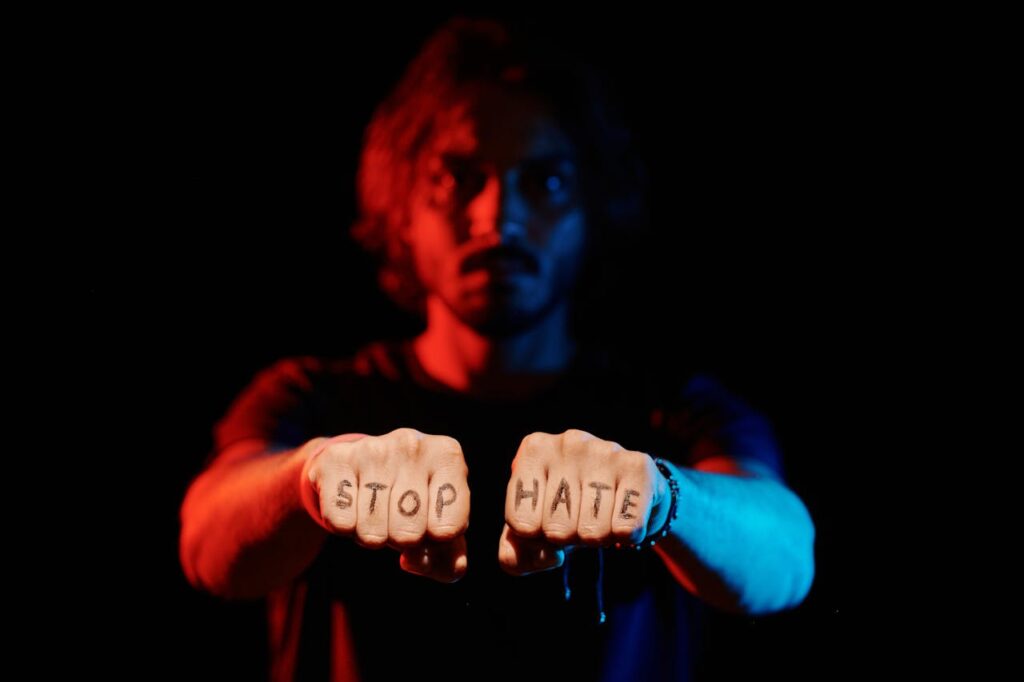
The Rise of Hate
You see it in your social media feeds and hear it in conversations around you with the rise of hate.
Hate seems to be rising, fueled by political divides and economic fears.
It’s creating rifts in communities and targeting vulnerable groups.
As tensions grow, it’s essential to understand where this hostility comes from and how it affects us all.
How can we combat this dangerous trend and foster a more inclusive environment?
The Role of Social Media in Amplifying Hate
As social media platforms continue to evolve, they inadvertently create spaces where hate can thrive.
You might notice how quickly harmful content spreads through likes, shares, and comments.
Algorithms prioritize engagement, often amplifying provocative posts that incite anger or division.
When you scroll through your feed, you may encounter inflammatory remarks that reinforce negative stereotypes or encourage hostility.
These interactions can foster echo chambers, where hateful ideologies gain traction among like-minded individuals.
You may find it alarming how easily misinformation can escalate into real-world consequences, as people act on the extreme views they encounter online.
It’s essential to recognize your role in this ecosystem; by consciously choosing what to engage with, you can help mitigate the spread of hate in your own online experience.
Political Polarization and Its Impact on Society
The rise of hate online has significantly contributed to increasing political polarization in society.
You’ve likely noticed how discussions that once felt civil have turned hostile.
Your friends and family might now seem divided over what used to be common beliefs.
This polarization creates an “us versus them” mentality, pushing people to retreat into echo chambers where only their views are validated.
As you engage with contentious topics, it’s easy to forget the humanity of those with differing opinions.
This divide can lead to mistrust and animosity, making it harder to find common ground.
Ultimately, political polarization not only strains relationships but also hinders collective problem-solving, leaving society less capable of addressing pressing issues that affect everyone.
Economic Uncertainty and the Rise of Scapegoating
Amidst rising economic uncertainty, many people seek someone to blame for their struggles, leading to a surge in scapegoating.
You might notice how this tendency manifests in communities, where individuals often target marginalized groups, believing they’re the cause of their hardships.
This misplaced anger creates a dangerous cycle, fueling division and hatred rather than fostering understanding.
When jobs disappear or prices rise, it’s easy to latch onto convenient narratives that simplify complex issues.
By pointing fingers, you might feel a temporary sense of relief, but it rarely solves the root problems.
Instead of uniting against a common challenge, scapegoating drives wedges between people, eroding trust and empathy.
In these times, it’s critical to seek solutions rather than scapegoats.
The Manifestations of Hate in Modern Communities
While many people strive for connection and understanding, hate often seeps into the fabric of modern communities in unsettling ways.
You might notice it in heated debates on social media, where hostile comments escalate quickly.
In your neighborhood, divisive graffiti or derogatory flyers can appear overnight, targeting specific groups.
Hate manifests in everyday interactions, too; you may hear slurs or witness bullying that creates an atmosphere of fear.
This toxic environment breeds isolation and mistrust among neighbors, making it tough to foster genuine relationships.
Even institutions can reflect this hate, with policies that marginalize certain communities.
Recognizing these manifestations is crucial; only then can you begin to understand the depth of the issue and its impact on your community’s cohesion.
Strategies for Collective Action Against Hate
Hate’s presence in our communities demands a proactive response. You can start by educating yourself and others about the roots of hate and its impact.
Organize workshops and discussions to raise awareness, fostering open dialogues that challenge stereotypes.
Collaborate with local organizations to create a united front against hate, amplifying your collective voice.
Engaging in social media campaigns can also help spread messages of tolerance and inclusion.
When you see hate speech or discrimination, don’t stay silent—report it and support those affected.
You can volunteer for initiatives that promote diversity and inclusion, helping to build bridges between different groups.
By standing together, you not only counteract hate but also create a culture of acceptance, resilience, and solidarity in your community.
In today’s world, it’s crucial to recognize the factors fueling hate and take action.
You can challenge divisive rhetoric on social media, engage in open conversations, and support marginalized communities facing scapegoating.
By fostering understanding and empathy, you contribute to breaking down the walls of mistrust for the rise of hate.
Together, we can create a more inclusive society where collective action against hate becomes the norm, paving the way for a brighter, more united future.